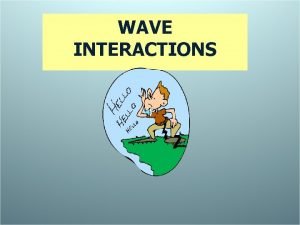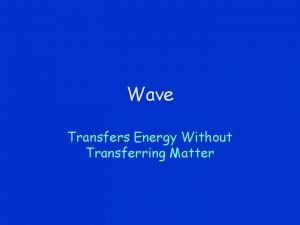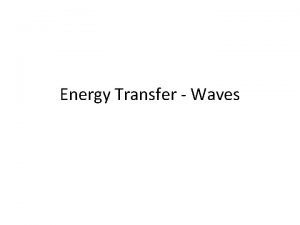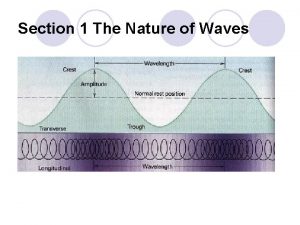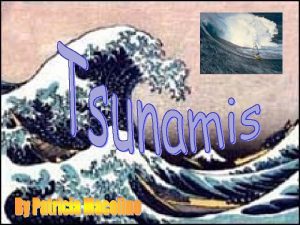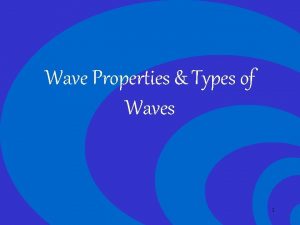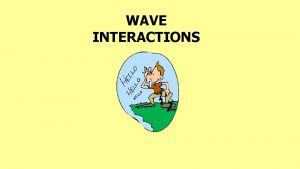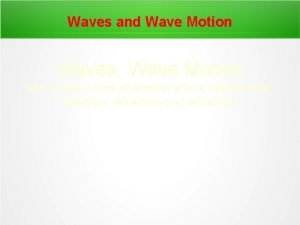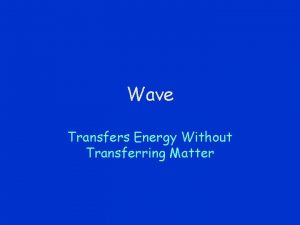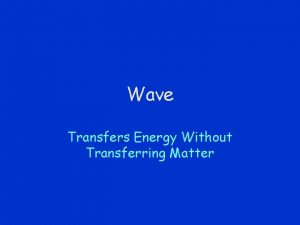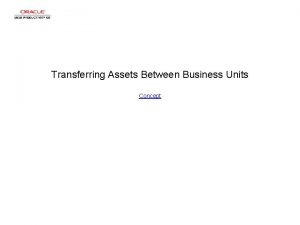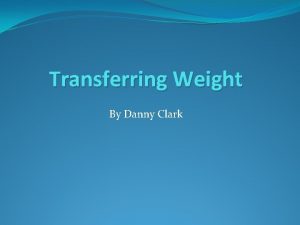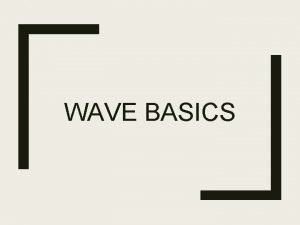Waves A wave is a means of transferring
































- Slides: 32

Waves • A wave is a means of transferring energy. A Transverse Wave The wave is vibrating perpendicular to the direction that the energy is moving. E. g. Light.

Polarisation A polarised wave vibrates in one plane only. The fact that light can be polarised proves that it is a transverse wave. Stress Polarisation

Proof that light is a transverse wave Pass light through two pieces of polaroid. Rotate one of them through 900. You will not be able to see through as light is polarised as it passes through the first piece of polaroid and cannot pass through the second. This proves that light is transverse. Note Polarised light vibrates in one direction only.

A longitudinal wave The wave vibrates in the same direction that the energy is moving. E. g. sound

Diffraction is the spreading of a wave when passing an obstacle or through a gap.

The closer the size of the gap to the wavelength of the wave, the greater the diffraction effect.

Interference causes the change in amplitude that occurs when waves meet.

Interference Constructive interference : The waves are in phase and combine to produce a greater amplitude. Destructive interference: The waves are 1800 out of phase and cancel each other out.

Homework 1. Define and give an example of (i) a transverse and (ii) a longitudinal wave. 2. A wave source emits a wave of wave length 1. 5 m with a frequency of 5 Hz. What is the speed of the waves? 3. What is meant by diffraction? How is it made more pronounced? 4. What is meant by interference?

Coherent waves – In phase and same frequency and amplitude Non coherent waves – Out of phase and destructive interference will occur.

The Ripple Tank

The Doppler effect The apparent change in the frequency of a wave due to the motion of the wave source. The frequency increases as the source of sound is moving towards the observer and decreases as the source moves away.

To demonstrate the Doppler effect in the lab Apparatus: buzzer and batteries Method: Place the buzzer and battery attached into a sock. Note the sound of the buzzer. Swing the buzzer in a horizontal circle and note the change in frequency. This is the Doppler Effect

The Doppler Effect

Harmonics in a stretched string Guitar, cello, violin f 2 f 3 f All harmonics are present Fundamental frequency f makes the longest wave that can fit, while other waves that fit are overtones. The fundamental frequency is the lowest frequency of vibration for that object.

Harmonics in a closed pipe e. g. Clarinet and trumpet f 3 f 5 f Only odd harmonics are present

Harmonics in an open pipe e. g. flute F 2 F 3 F 4 F All harmonics are present. 5 F

SOUND • Sound is a wave produced by vibrations. • An echo is a reflected sound. • Sound travels slower than light. • Sound needs a medium to travel in. There is no sound in a vacuum. • To prove that sound is a wave we must show that it undergoes interference and diffraction.

To prove that sound is a wave ØMethod: Strike a tuning fork and rotate it beside your ear. ØResult: The sound increases and decreases ØReason: Sound vibrations are undergoing interference.

Speed of sound in various media • The more dense the medium the greater the speed. • The speed of sound in air varies with temperature. • The greater the temperature of the air the faster sound travels.

Sound needs a medium to travel in. As air is removed from the bell jar, the sound of the bell reduces until it can no longer be heard, even though the hammer is still hitting the gong.

Factors affecting sound Frequency of a sound wave controls pitch. Quality is affected by the number of overtones present. Amplitude of a sound wave controls loudness.

Frequency limits of Audibility • These are the highest and lowest audible frequencies for the human ear. 20 Hz to 20 k. Hz Dog whistle

Resonance • This is the transfer of energy between objects of the same natural frequency. • Tacoma Bridge • Bartons Pendulums-Lab demonstration of resonance • Tuning forks


Beats • Beats are created when sound waves of slightly differing frequency meet.

Sound intensity level • Sound intensity is the rate at which sound energy passes unit area at right angles to the direction in which the sound is travelling. • The unit: W/m 2 • Sound intensity level is measured in decibels. • Threshold of hearing is the lowest audible sound intensity at a frequency of 1000 Hz. (10 -12 W/m 2) • When the sound intensity doubles the sound intensity level goes up 3 d. B.


Harmonics in a stretched string Guitar, cello, violin f 2 f 3 f All harmonics are present Fundamental frequency f makes the longest wave that can fit, while other waves that fit are overtones. The fundamental frequency is the lowest frequency of vibration for that object.

Harmonics in a closed pipe e. g. Clarinet and trumpet f 3 f 5 f Only odd harmonics are present

Harmonics in an open pipe e. g. flute All harmonics are present.

Overtones are the other frequencies besides the fundamental that exist in musical instruments. Instruments of different shapes produce different overtones. For example, both the waves are the same frequency, and therefore the same note. But their overtones are different, and therefore their sounds are different.
 How do waves transfer energy without transferring matter
How do waves transfer energy without transferring matter A wave transfers
A wave transfers What transmits energy without transferring matter
What transmits energy without transferring matter Difference between matter waves and electromagnetic waves
Difference between matter waves and electromagnetic waves Parts of a longitudinal wave
Parts of a longitudinal wave Is a seismic wave mechanical or electromagnetic
Is a seismic wave mechanical or electromagnetic The difference between constructive and destructive waves
The difference between constructive and destructive waves The wave chapter 13
The wave chapter 13 Examples of mechanical and electromagnetic waves
Examples of mechanical and electromagnetic waves Sound waves are longitudinal waves true or false
Sound waves are longitudinal waves true or false Sound waves longitudinal waves
Sound waves longitudinal waves Compare and contrast p waves and s waves using venn diagram
Compare and contrast p waves and s waves using venn diagram Mechanical and electromagnetic waves similarities
Mechanical and electromagnetic waves similarities Mechanical and electromagnetic waves similarities
Mechanical and electromagnetic waves similarities What is a semiconductor used for
What is a semiconductor used for Seismic waves
Seismic waves Electromagnetic and mechanical waves
Electromagnetic and mechanical waves Similarities of mechanical waves and electromagnetic waves
Similarities of mechanical waves and electromagnetic waves Ability of two or more waves to combine and form a new wave
Ability of two or more waves to combine and form a new wave Waves means
Waves means Tsunami japanese meaning
Tsunami japanese meaning Center tapped bridge rectifier
Center tapped bridge rectifier Wave wave repeating
Wave wave repeating Difference between full wave and half wave rectifier
Difference between full wave and half wave rectifier Determining the arrival times between p-wave and s-wave
Determining the arrival times between p-wave and s-wave Quarter wave symmetry fourier series
Quarter wave symmetry fourier series Difference between transverse wave and longitudinal wave
Difference between transverse wave and longitudinal wave Full wave rectified sine wave fourier series
Full wave rectified sine wave fourier series Examples of half wave rectifier
Examples of half wave rectifier Wavelength formula triangle
Wavelength formula triangle A ____ is a repeating disturbance or movement that
A ____ is a repeating disturbance or movement that Transferring lifting repositioning
Transferring lifting repositioning Phosporyl
Phosporyl
